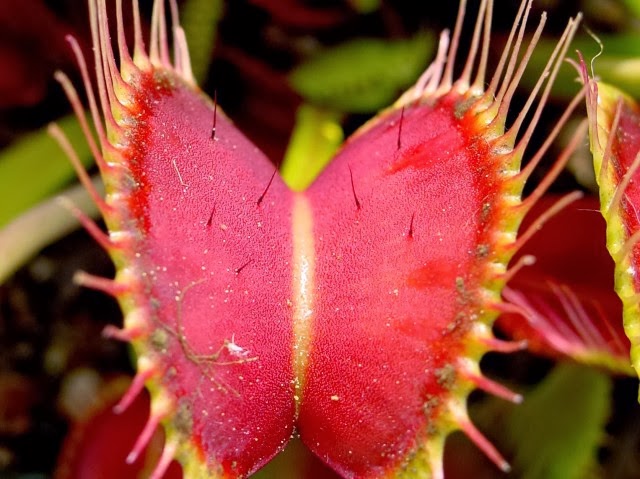The
Venus Flytrap is the most well-known carnivorous plant, and is especially
amazing to watch. There are small trigger hairs on the leaves which causes them
to fold together when they are touched. The leaves close in less than a second,
and the teeth-like spikes on the edge keep larger insects from escaping. The
Venus Flytrap is native only to the nitrogen-poor bogs and savannas in North
and South Carolina, US. A video of the Flytrap catching a fly can be found
here, and a live Venus Flytrap can be purchased here if you are interested.
The
Venus flytrap (also Venus's flytrap or Venus' flytrap), Dionaea muscipula, is a
carnivorous plant native to subtropical wetlands on the East Coast of the
United States. It catches its prey—chiefly insects and arachnids— with a
trapping structure formed by the terminal portion of each of the plant's leaves
and is triggered by tiny hairs on their inner surfaces. When an insect or
spider crawling along the leaves contacts a hair, the trap closes if a
different hair is contacted within twenty seconds of the first strike. The
requirement of redundant triggering in this mechanism serves as a safeguard
against a waste of energy in trapping objects with no nutritional value.
Description
The
Venus flytrap is a small plant whose structure can be described as a rosette of
four to seven leaves, which arise from a short subterranean stem that is
actually a bulb-like object. Each stem reaches a maximum size of about three to
ten centimeters, depending on the time of year; longer leaves with robust traps
are usually formed after flowering. Flytraps that have more than 7 leaves are
colonies formed by rosettes that have divided beneath the ground.
The
leaf blade is divided into two regions: a flat, heart-shaped
photosynthesis-capable petiole, and a pair of terminal lobes hinged at the
midrib, forming the trap which is the true leaf. The upper surface of these
lobes contains redanthocyanin pigments and its edges secrete mucilage. The
lobes exhibit rapid plant movements, snapping shut when stimulated by prey. The
trapping mechanism is tripped when prey contacts one of the three hair-like
trichomes that are found on the upper surface of each of the lobes. The
trapping mechanism is so specialized that it can distinguish between living
prey and non-prey stimuli such as falling raindrops; two trigger hairs must be
touched in succession within 20 seconds of each other or one hair touched twice
in rapid succession, whereupon the lobes of the trap will snap shut in about
one-tenth of a second. The edges of the lobes are fringed by stiff hair-like
protrusions or cilia, which mesh together and prevent large prey from escaping.
(These protrusions, and the trigger hairs, also known as sensitive hairs, are
probably homologous with the tentacles found in this plant’s close relatives,
the sundews.) Scientists have concluded that the Venus flytrap is closely
related to Drosera (sundews), and that the snap trap evolved from a fly-paper
trap similar to that of Drosera.
The
holes in the meshwork allow small prey to escape, presumably because the
benefit that would be obtained from them would be less than the cost of
digesting them. If the prey is too small and escapes, the trap will reopen
within 12 hours. If the prey moves around in the trap, it tightens and
digestion begins more quickly.
Speed
of closing can vary depending on the amount of humidity, light, size of prey,
and general growing conditions. The speed with which traps close can be used as
an indicator of a plant's general health. Venus flytraps are not as
humidity-dependent as are some other carnivorous plants, such as Nepenthes,
Cephalotus, most Heliamphora, and some Drosera.
The
Venus flytrap exhibits variations in petiole shape and length and whether the
leaf lies flat on the ground or extends up at an angle of about 40–60 degrees.
The four major forms are: 'typica', the most common, with broad decumbent
petioles; 'erecta', with leaves at a 45-degree angle; 'linearis', with narrow
petioles and leaves at 45 degrees; and 'filiformis', with extremely narrow or
linear petioles. Except for 'filiformis', all of these can be stages in leaf
production of any plant depending on season (decumbent in summer versus short
versus semi-erect in spring), length of photoperiod (long petioles in spring
versus short in summer), and intensity of light (wide petioles in low light
intensity versus narrow in brighter light).
When
grown from seed, plants take around four to five years to reach maturity and
will live for 20 to 30 years if cultivated in the right conditions.
Venus flytraps produce flowers in the spring






.jpg)
.jpg)














































